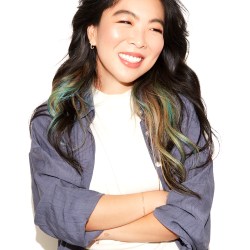I'm going to start by saying that, on the whole, I wouldn’t advise bleaching your hair at home. I've seen firsthand just how disastrous the results can be, and having interviewed many hairstylists throughout the years, I know just how finicky bleach (aka hydrogen peroxide) can be to handle. That said, I acknowledge that some of you are more adept with your hair coloring skills and others might not be able afford to get their hair professionally done at the moment, so I asked celebrity hairstylist DaRico Jackson to share some of his best tips for safely bleaching your hair at home.
Bleaching Hair at Home: The Do's and Don’ts, According to a Hairstylist
Read this before you proceed
Meet the Expert
DaRico Jackson is a celebrity hairstylist with over three decades of experience. After attending school at The Academy of Scientific Hair Design, he then went on to The National Academy of Beauty Arts completing special studies under the scientific educational system of Redken. His work has been featured in publications such as Vogue, Harper’s BAZAAR, People Magazine, Ebony and Essence, and on celebrities such as Vivica Fox, Angela Bassett and Paula Abdul.
The Risks of Bleaching Your Hair
Bleaching your hair will cause damage to it, whether you do it at home or at a salon. That's because the bleach works by breaking down the protein bonds in your hair, so that the pigment is lifted from it, which is how you lighten up your color. This process inevitably results in drier strands. Other common signs of damage you might see include breakage, frizz, scalp irritation and discoloration (particularly if you've colored your hair before). The extent of these side effects, however, can vary so it's worth doing your research and/or enlisting a professional to minimize damage.
When Should You Bleach at Home and When Should You Avoid It?
For starters, “You’ll want to examine your hair and make sure that it’s in optimum condition, meaning it’s in good health and strong enough to handle the process,” says Jackson. If you see a lot of splitting, dryness or weakened ends, hold off on the bleach, which can cause more damage and even breakage.
“If you’ve determined that it’s safe to proceed, I’d recommend starting with a test strand. First, take a small strand from the lower back region and apply a small amount of the color to see if you have any allergic reactions or scalp irritation from it,” explains Jackson. “Go with lower levels of developer and lift the color slowly instead of going in with a higher level of developer (like 40 volume) to get faster results,” he adds. Slow and steady is the name of the game here.
The Do's and Don'ts for Bleaching Your Hair at Home
“First off, note the difference between overall color vs a retouch,” says Jackson. “If you are doing a color retouch, you should only apply the bleach to the area of regrowth and try to avoid excessive overlapping of the previous color application.”
And if you’re going for overall color, “you must start in the center or hair shaft and avoid the hair ends until last,” says Jackson. If you’re wondering why you’d start in the center as opposed to the roots, that’s because “your body temperature speeds up processing, causing the hair to go lighter at the scalp and produce an uneven result, which stylists refer to that as ‘hot roots.’”
So, to clarify, when applying overall color, start at the center or mid-lengths, then your roots and finish with the ends. Got it? OK, moving along.
How to Bleach Your Hair at Home
- Step 1: Read the manufacturer’s instructions carefully.
- Step 2: “Start with parting your hair into four sections (forehead to nape and ear to ear) and clip away each section separately. You will find that it is easier to work through the hair one section at a time,” explains Jackson.
- Step 3: “Mix equal amounts of bleach to developer (2 ounces of each) until it’s creamy like pancake batter. Start your timer for 45 minutes.”
- Step 4: Next, start your application in the front two sections, work your way to the back two, making sure to apply the color evenly. Process for the remaining time on the timer.
- Step 5: Shampoo thoroughly, then do a deep conditioner or treatment for 3 to 5 minutes, rinse well and blot hair dry.
Products Needed for At-Home Bleaching
You’ll need a plastic bowl and measuring cup, as well as a brush, hair clips and a cape or some sort of covering for your shoulders to prevent staining your clothing. On that note, make sure not to wear anything you’d be sad about getting messy, and proceed from a well-ventilated space.
As for specific products, Jackson recommends the Clairol Professional and Wella ColorCharm lines because “they all work great for at-home use to create beautiful blondes.”
Hair Care After Bleaching
As anyone with bleached hair knows, it’s a constant battle against brass and breakage, so make sure to get yourself a good purple shampoo. (FYI: Jackson likes Clairol Shimmer Lights for maintaining the hair's integrity, while revitalizing your color whenever you wash.) We’d also recommend a good mask to use weekly and a showerhead filter to remove any potentially dulling minerals and metals from your water.
Alternatives to Bleaching Hair
If you're looking to lighten up your hair, but want to minimize the amount of damage that can result from an all-over processing job, you could also try balayage, baby highlights or even peekaboo highlights, which bleach smaller sections of your hair.
Bottom line: A DIY bleach job, though not encouraged, can be done. But if you decide to go this route, make sure to follow the instructions on the box to a T and continuously monitor your hair as it's processing to make sure you don't leave the bleach on for too long.




